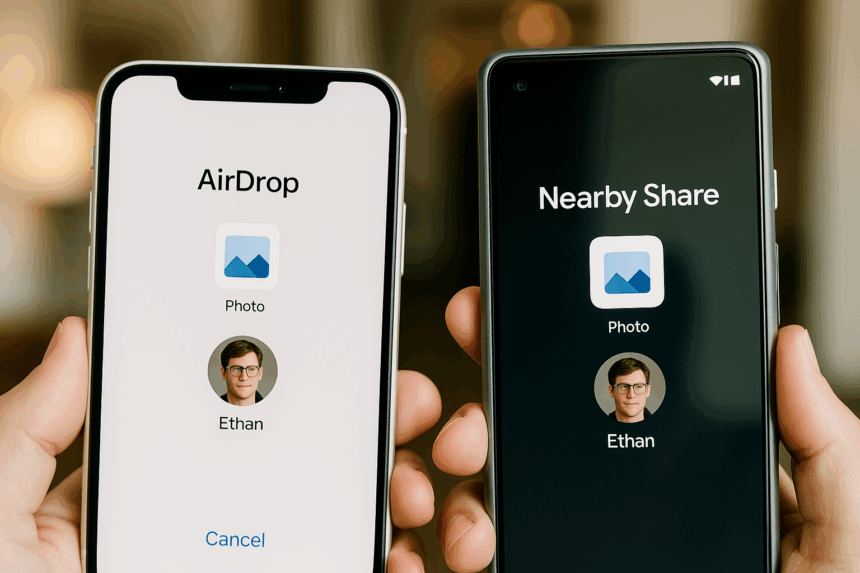Apple’s AirDrop running on a Google Pixel 10 sounds like the sort of invention from The Onion. Yet here we are. Thanks to the EU’s interoperability rules — and a quiet but important change inside Apple — the simple tap-and-send magic once locked to iPhones reaches Android’s newest flagship. It’s strange at first. Then it feels overdue.
The update is real cross-platform convenience in everyday life. Photos, documents, and videos can move between devices without email, links, or cloud detours. The Pixel 10 is the first Android phone to support an AirDrop-compatible experience. The timing says everything about where the future of device interoperability is heading.
What’s Happening & Why This Matters
Apple Adds Cross-Platform Sharing Under EU Pressure

The EU’s Digital Markets Act (DMA) forced leading platforms to open up features that were once locked tight. Apple responded with a new standard called Device-to-Device Interoperability Protocol (D2DIP) — a framework that lets devices, regardless of brand, share content at close range.
Google jumped with the Pixel 10 as the first partner. During a recent demo, Google engineers showed AirDrop-style sharing between the Pixel 10 and an iPhone with only a handshake prompt and a simple confirmation.
Apple describes the compatibility update as an “enhanced user mobility across platforms.” Behind the polite phrasing is an evolving strategy. After years of resisting interoperability, Apple extends AirDrop-style functionality because EU regulators require it, and because users demand it.
Google Integrates the Protocol Into Android
Google adds the new interoperability tech into Android’s sharing stack. If fits alongside Nearby Share, but the protocol makes sharing with Apple devices faster and more consistent. No pairing, scanning, or Bluetooth awkwardness.
A Pixel engineer said the new protocol “lets devices talk in a shared language rather than forcing translation.” That language uses Bluetooth for discovery and Wi-Fi Direct for the transfer itself. The effect feels very close to AirDrop’s performance on iPhone-to-iPhone transfers.
The Pixel 10 Becomes the First Android Device to Support It
Google confirms Pixel 10 support at launch. More Android OEMs, including Samsung and Nothing, are reviewing the protocol now. The EU’s objective is clear: remove friction that traps users inside ecosystems. Shared features encourage competition based on product quality, not device lock-in.

This pushes Apple into unfamiliar territory. Each step toward open features dilutes the historical “iPhone advantage.” AirDrop has been one of Apple’s most reliable ecosystem anchors. Losing exclusivity transforms the competitive landscape, especially with younger users who already share across mixed device environments.
Google benefits immediately. The Pixel 10 gains a headline feature that normally belongs in Apple keynotes. This also positions Google as a leader in cross-platform cooperation, a theme that resonates in an industry where regulators watch every move.
Real-World Usage Looks Surprisingly Smooth
Early testers report quick device discovery and fast file transfers between the Pixel 10 and iPhone. The UI still differs on each device, but the transfer flow remains simple — tap share, tap device, accept transfer.
One tester described the experience with understatement:
“It works. It feels normal. And that’s the surprise.”
Behind the scenes, compatibility relies on strict peer-to-peer encryption rules the EU now expects. Apple notes that the protocol “maintains end-to-end protections consistent with AirDrop’s security model.” Google echoes this, adding that encryption performance remains stable even with large file sizes.
TF Summary: What’s Next
Interoperability is only the beginning. The EU’s DMA enforces more cross-platform goodness over the next two years. Messaging, payments, and app distribution are still being examined. AirDrop-style sharing with rival devices establishes new ground for bigger changes.
MY FORECAST: Expect AirDrop protocol to spread across Android’s top manufacturers by mid-2026. Apple will continue to comply while doing everything possible to make the interoperability “just enough” rather than fully equal to iPhone-to-iPhone AirDrop. Still, the wall around Apple’s ecosystem has its first real doorway — and it opens wider from here.
— Text-to-Speech (TTS) provided by gspeech


